HI6008 - Research Proposal on Outsourcing: Benefits and Limitations
VerifiedAdded on 2023/06/11
|13
|2825
|252
Report
AI Summary
This research proposal delves into the advantages and disadvantages of outsourcing business functions, a prevalent practice in modern organizations. It begins by defining outsourcing and highlighting its increasing importance, particularly in areas like human resources, procurement, and IT. The proposal outlines the objective of the research, which is to ascertain the benefits and limitations of outsourcing, and details the scope of work, covering various business operations that can be outsourced. It includes a literature review, examining different types of outsourcing, its relationship with technology, and the resource-based and transaction cost approaches. The proposal also presents a hypothesis, research methodology employing both qualitative and quantitative methods, a time schedule, and limitations encountered during the research process. The study aims to provide a balanced perspective on outsourcing, considering both its potential benefits, such as cost reduction, improved performance, and access to technology, and its risks, including loss of control and potential reduction in service quality.
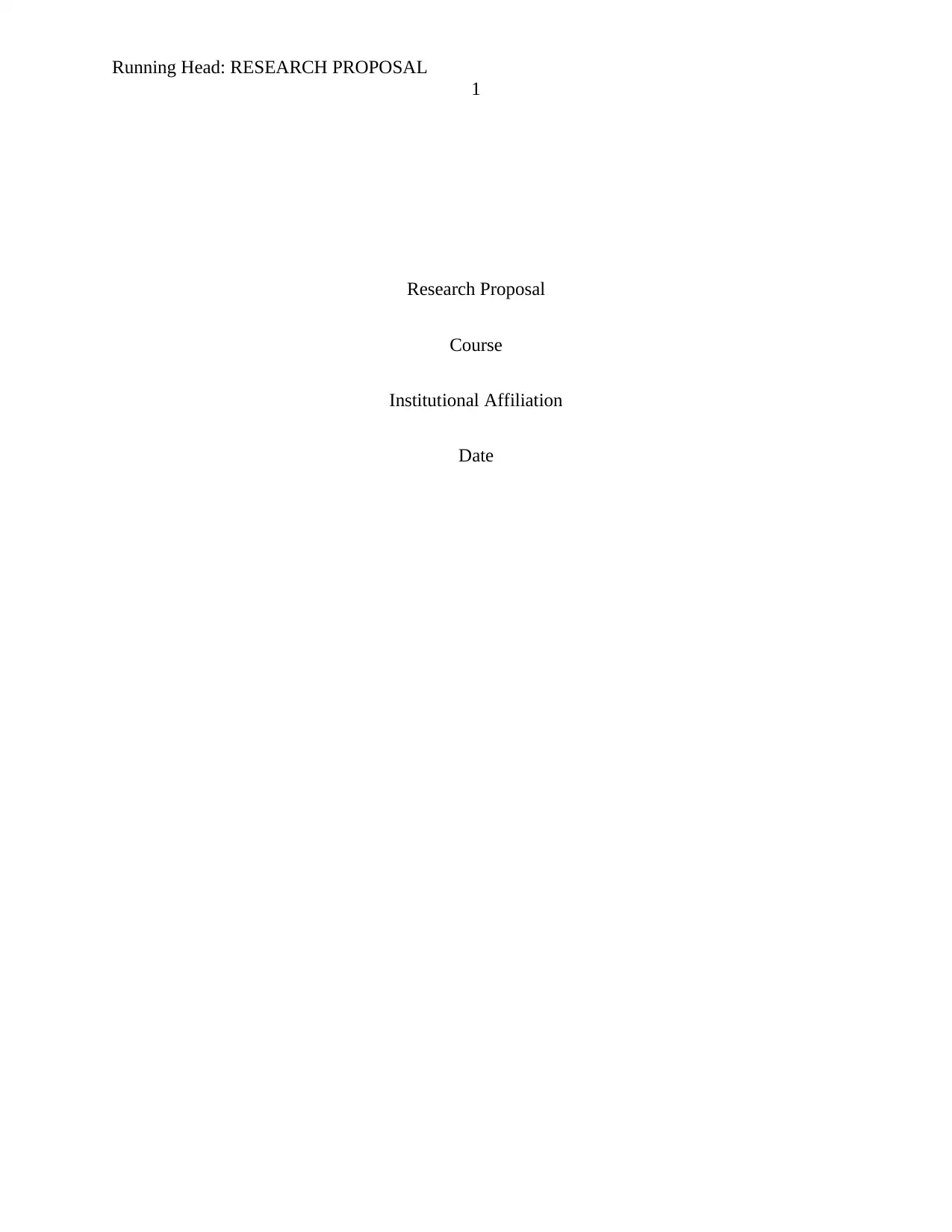
Running Head: RESEARCH PROPOSAL
1
Research Proposal
Course
Institutional Affiliation
Date
1
Research Proposal
Course
Institutional Affiliation
Date
Paraphrase This Document
Need a fresh take? Get an instant paraphrase of this document with our AI Paraphraser
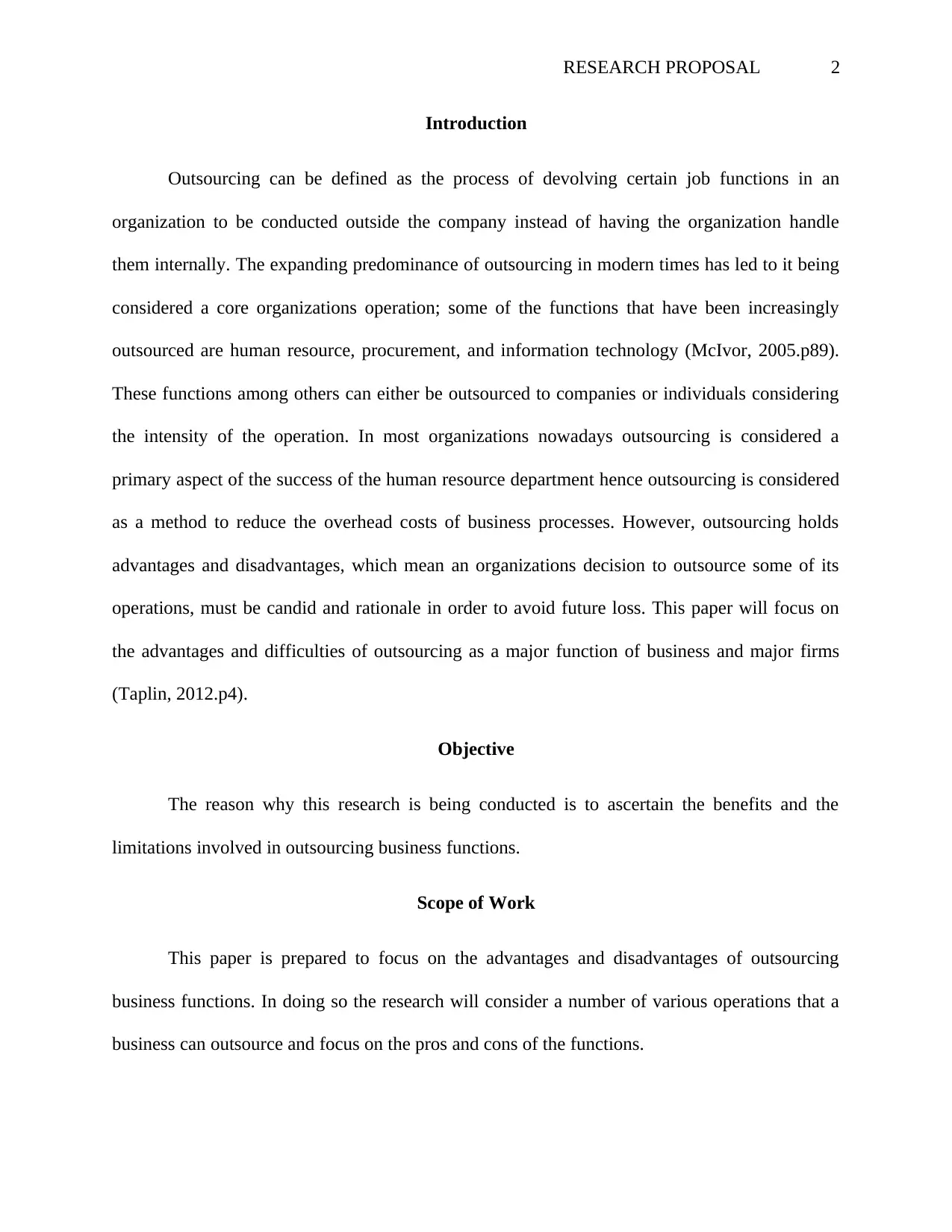
RESEARCH PROPOSAL 2
Introduction
Outsourcing can be defined as the process of devolving certain job functions in an
organization to be conducted outside the company instead of having the organization handle
them internally. The expanding predominance of outsourcing in modern times has led to it being
considered a core organizations operation; some of the functions that have been increasingly
outsourced are human resource, procurement, and information technology (McIvor, 2005.p89).
These functions among others can either be outsourced to companies or individuals considering
the intensity of the operation. In most organizations nowadays outsourcing is considered a
primary aspect of the success of the human resource department hence outsourcing is considered
as a method to reduce the overhead costs of business processes. However, outsourcing holds
advantages and disadvantages, which mean an organizations decision to outsource some of its
operations, must be candid and rationale in order to avoid future loss. This paper will focus on
the advantages and difficulties of outsourcing as a major function of business and major firms
(Taplin, 2012.p4).
Objective
The reason why this research is being conducted is to ascertain the benefits and the
limitations involved in outsourcing business functions.
Scope of Work
This paper is prepared to focus on the advantages and disadvantages of outsourcing
business functions. In doing so the research will consider a number of various operations that a
business can outsource and focus on the pros and cons of the functions.
Introduction
Outsourcing can be defined as the process of devolving certain job functions in an
organization to be conducted outside the company instead of having the organization handle
them internally. The expanding predominance of outsourcing in modern times has led to it being
considered a core organizations operation; some of the functions that have been increasingly
outsourced are human resource, procurement, and information technology (McIvor, 2005.p89).
These functions among others can either be outsourced to companies or individuals considering
the intensity of the operation. In most organizations nowadays outsourcing is considered a
primary aspect of the success of the human resource department hence outsourcing is considered
as a method to reduce the overhead costs of business processes. However, outsourcing holds
advantages and disadvantages, which mean an organizations decision to outsource some of its
operations, must be candid and rationale in order to avoid future loss. This paper will focus on
the advantages and difficulties of outsourcing as a major function of business and major firms
(Taplin, 2012.p4).
Objective
The reason why this research is being conducted is to ascertain the benefits and the
limitations involved in outsourcing business functions.
Scope of Work
This paper is prepared to focus on the advantages and disadvantages of outsourcing
business functions. In doing so the research will consider a number of various operations that a
business can outsource and focus on the pros and cons of the functions.
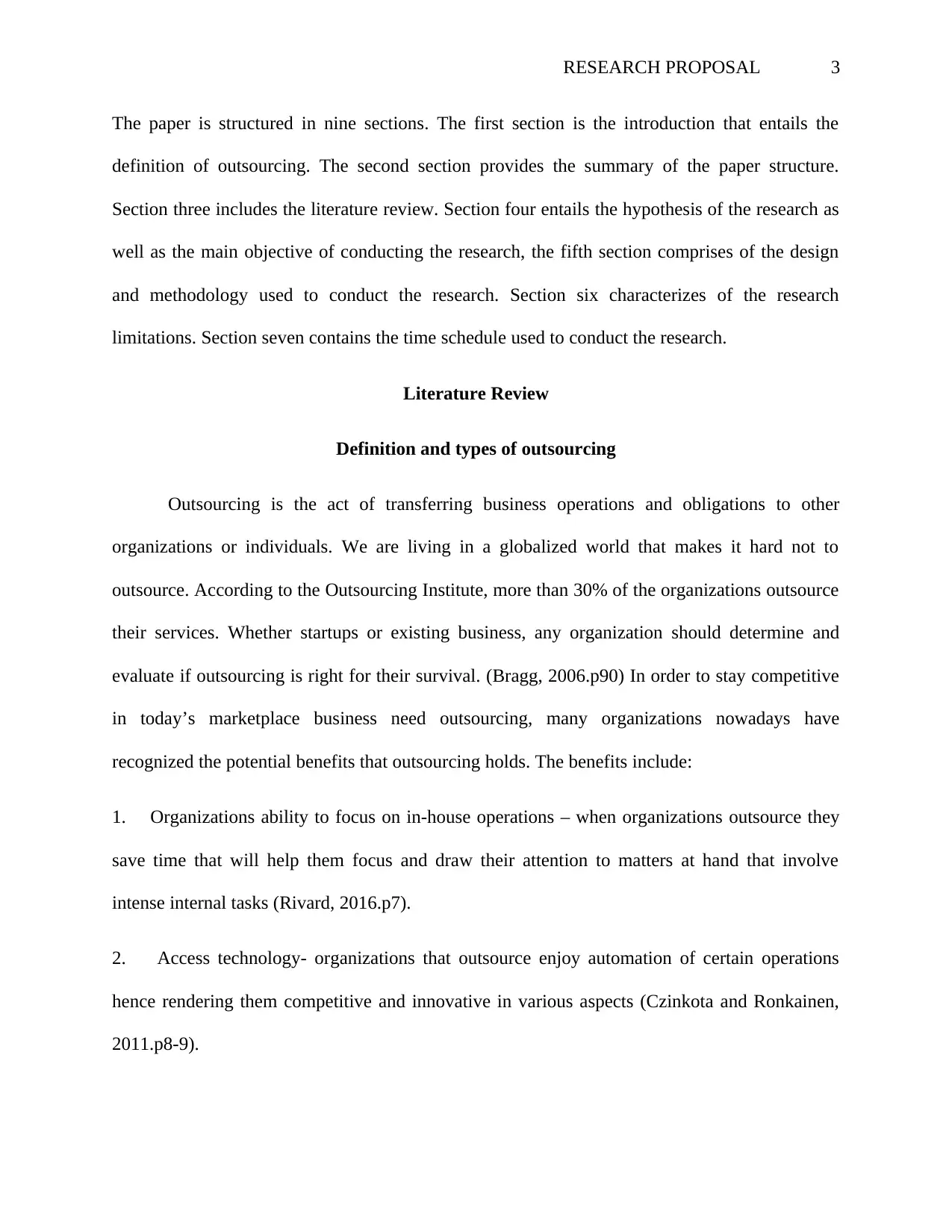
RESEARCH PROPOSAL 3
The paper is structured in nine sections. The first section is the introduction that entails the
definition of outsourcing. The second section provides the summary of the paper structure.
Section three includes the literature review. Section four entails the hypothesis of the research as
well as the main objective of conducting the research, the fifth section comprises of the design
and methodology used to conduct the research. Section six characterizes of the research
limitations. Section seven contains the time schedule used to conduct the research.
Literature Review
Definition and types of outsourcing
Outsourcing is the act of transferring business operations and obligations to other
organizations or individuals. We are living in a globalized world that makes it hard not to
outsource. According to the Outsourcing Institute, more than 30% of the organizations outsource
their services. Whether startups or existing business, any organization should determine and
evaluate if outsourcing is right for their survival. (Bragg, 2006.p90) In order to stay competitive
in today’s marketplace business need outsourcing, many organizations nowadays have
recognized the potential benefits that outsourcing holds. The benefits include:
1. Organizations ability to focus on in-house operations – when organizations outsource they
save time that will help them focus and draw their attention to matters at hand that involve
intense internal tasks (Rivard, 2016.p7).
2. Access technology- organizations that outsource enjoy automation of certain operations
hence rendering them competitive and innovative in various aspects (Czinkota and Ronkainen,
2011.p8-9).
The paper is structured in nine sections. The first section is the introduction that entails the
definition of outsourcing. The second section provides the summary of the paper structure.
Section three includes the literature review. Section four entails the hypothesis of the research as
well as the main objective of conducting the research, the fifth section comprises of the design
and methodology used to conduct the research. Section six characterizes of the research
limitations. Section seven contains the time schedule used to conduct the research.
Literature Review
Definition and types of outsourcing
Outsourcing is the act of transferring business operations and obligations to other
organizations or individuals. We are living in a globalized world that makes it hard not to
outsource. According to the Outsourcing Institute, more than 30% of the organizations outsource
their services. Whether startups or existing business, any organization should determine and
evaluate if outsourcing is right for their survival. (Bragg, 2006.p90) In order to stay competitive
in today’s marketplace business need outsourcing, many organizations nowadays have
recognized the potential benefits that outsourcing holds. The benefits include:
1. Organizations ability to focus on in-house operations – when organizations outsource they
save time that will help them focus and draw their attention to matters at hand that involve
intense internal tasks (Rivard, 2016.p7).
2. Access technology- organizations that outsource enjoy automation of certain operations
hence rendering them competitive and innovative in various aspects (Czinkota and Ronkainen,
2011.p8-9).
⊘ This is a preview!⊘
Do you want full access?
Subscribe today to unlock all pages.

Trusted by 1+ million students worldwide
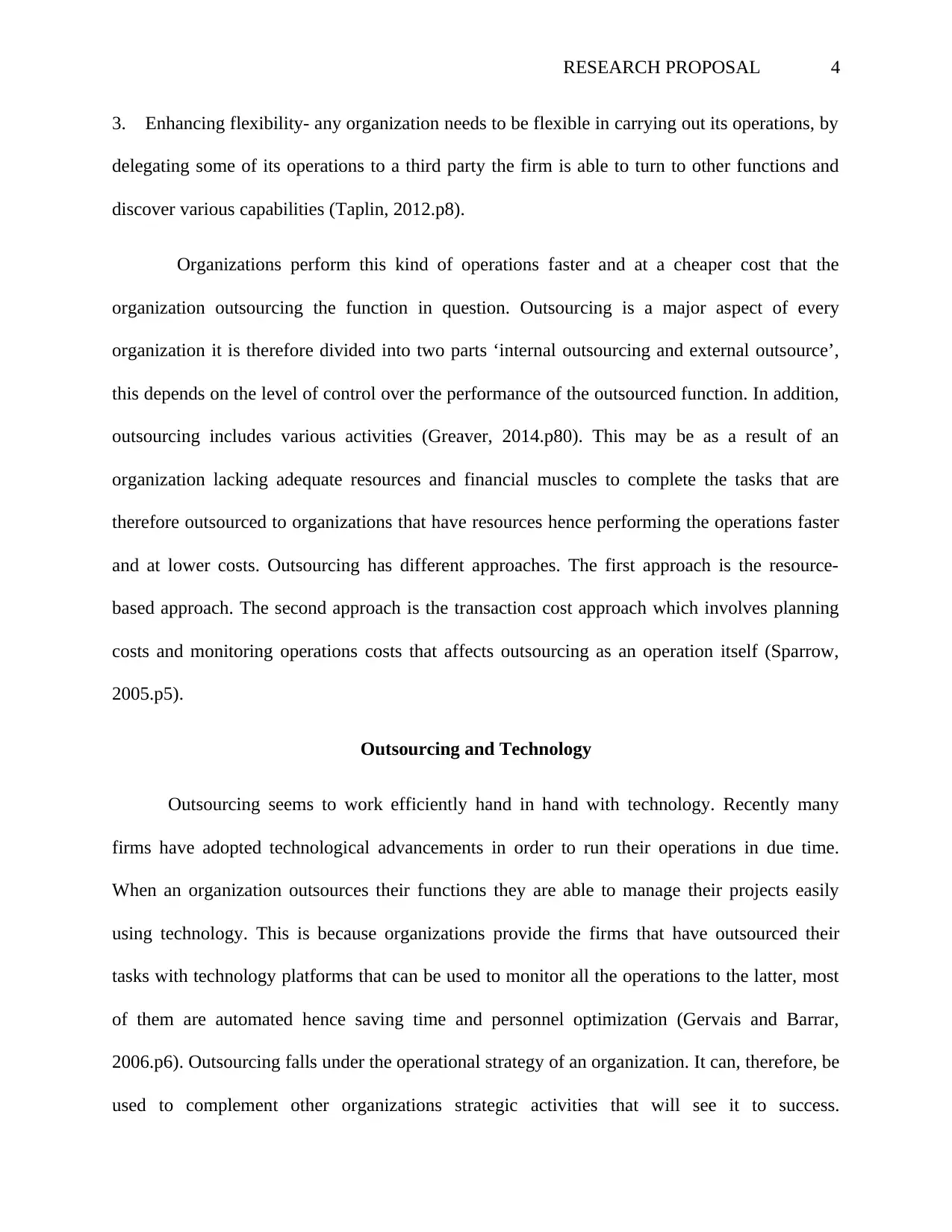
RESEARCH PROPOSAL 4
3. Enhancing flexibility- any organization needs to be flexible in carrying out its operations, by
delegating some of its operations to a third party the firm is able to turn to other functions and
discover various capabilities (Taplin, 2012.p8).
Organizations perform this kind of operations faster and at a cheaper cost that the
organization outsourcing the function in question. Outsourcing is a major aspect of every
organization it is therefore divided into two parts ‘internal outsourcing and external outsource’,
this depends on the level of control over the performance of the outsourced function. In addition,
outsourcing includes various activities (Greaver, 2014.p80). This may be as a result of an
organization lacking adequate resources and financial muscles to complete the tasks that are
therefore outsourced to organizations that have resources hence performing the operations faster
and at lower costs. Outsourcing has different approaches. The first approach is the resource-
based approach. The second approach is the transaction cost approach which involves planning
costs and monitoring operations costs that affects outsourcing as an operation itself (Sparrow,
2005.p5).
Outsourcing and Technology
Outsourcing seems to work efficiently hand in hand with technology. Recently many
firms have adopted technological advancements in order to run their operations in due time.
When an organization outsources their functions they are able to manage their projects easily
using technology. This is because organizations provide the firms that have outsourced their
tasks with technology platforms that can be used to monitor all the operations to the latter, most
of them are automated hence saving time and personnel optimization (Gervais and Barrar,
2006.p6). Outsourcing falls under the operational strategy of an organization. It can, therefore, be
used to complement other organizations strategic activities that will see it to success.
3. Enhancing flexibility- any organization needs to be flexible in carrying out its operations, by
delegating some of its operations to a third party the firm is able to turn to other functions and
discover various capabilities (Taplin, 2012.p8).
Organizations perform this kind of operations faster and at a cheaper cost that the
organization outsourcing the function in question. Outsourcing is a major aspect of every
organization it is therefore divided into two parts ‘internal outsourcing and external outsource’,
this depends on the level of control over the performance of the outsourced function. In addition,
outsourcing includes various activities (Greaver, 2014.p80). This may be as a result of an
organization lacking adequate resources and financial muscles to complete the tasks that are
therefore outsourced to organizations that have resources hence performing the operations faster
and at lower costs. Outsourcing has different approaches. The first approach is the resource-
based approach. The second approach is the transaction cost approach which involves planning
costs and monitoring operations costs that affects outsourcing as an operation itself (Sparrow,
2005.p5).
Outsourcing and Technology
Outsourcing seems to work efficiently hand in hand with technology. Recently many
firms have adopted technological advancements in order to run their operations in due time.
When an organization outsources their functions they are able to manage their projects easily
using technology. This is because organizations provide the firms that have outsourced their
tasks with technology platforms that can be used to monitor all the operations to the latter, most
of them are automated hence saving time and personnel optimization (Gervais and Barrar,
2006.p6). Outsourcing falls under the operational strategy of an organization. It can, therefore, be
used to complement other organizations strategic activities that will see it to success.
Paraphrase This Document
Need a fresh take? Get an instant paraphrase of this document with our AI Paraphraser
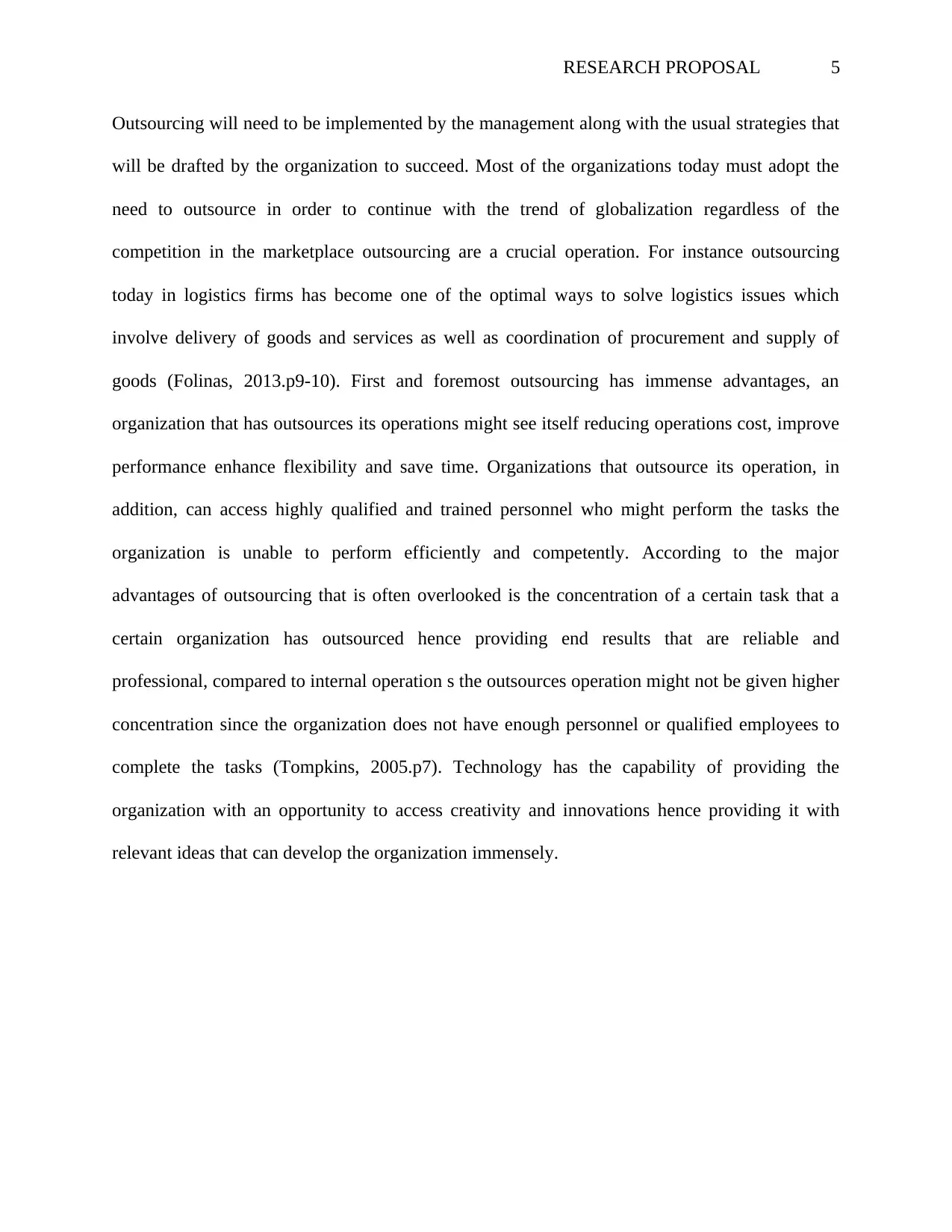
RESEARCH PROPOSAL 5
Outsourcing will need to be implemented by the management along with the usual strategies that
will be drafted by the organization to succeed. Most of the organizations today must adopt the
need to outsource in order to continue with the trend of globalization regardless of the
competition in the marketplace outsourcing are a crucial operation. For instance outsourcing
today in logistics firms has become one of the optimal ways to solve logistics issues which
involve delivery of goods and services as well as coordination of procurement and supply of
goods (Folinas, 2013.p9-10). First and foremost outsourcing has immense advantages, an
organization that has outsources its operations might see itself reducing operations cost, improve
performance enhance flexibility and save time. Organizations that outsource its operation, in
addition, can access highly qualified and trained personnel who might perform the tasks the
organization is unable to perform efficiently and competently. According to the major
advantages of outsourcing that is often overlooked is the concentration of a certain task that a
certain organization has outsourced hence providing end results that are reliable and
professional, compared to internal operation s the outsources operation might not be given higher
concentration since the organization does not have enough personnel or qualified employees to
complete the tasks (Tompkins, 2005.p7). Technology has the capability of providing the
organization with an opportunity to access creativity and innovations hence providing it with
relevant ideas that can develop the organization immensely.
Outsourcing will need to be implemented by the management along with the usual strategies that
will be drafted by the organization to succeed. Most of the organizations today must adopt the
need to outsource in order to continue with the trend of globalization regardless of the
competition in the marketplace outsourcing are a crucial operation. For instance outsourcing
today in logistics firms has become one of the optimal ways to solve logistics issues which
involve delivery of goods and services as well as coordination of procurement and supply of
goods (Folinas, 2013.p9-10). First and foremost outsourcing has immense advantages, an
organization that has outsources its operations might see itself reducing operations cost, improve
performance enhance flexibility and save time. Organizations that outsource its operation, in
addition, can access highly qualified and trained personnel who might perform the tasks the
organization is unable to perform efficiently and competently. According to the major
advantages of outsourcing that is often overlooked is the concentration of a certain task that a
certain organization has outsourced hence providing end results that are reliable and
professional, compared to internal operation s the outsources operation might not be given higher
concentration since the organization does not have enough personnel or qualified employees to
complete the tasks (Tompkins, 2005.p7). Technology has the capability of providing the
organization with an opportunity to access creativity and innovations hence providing it with
relevant ideas that can develop the organization immensely.
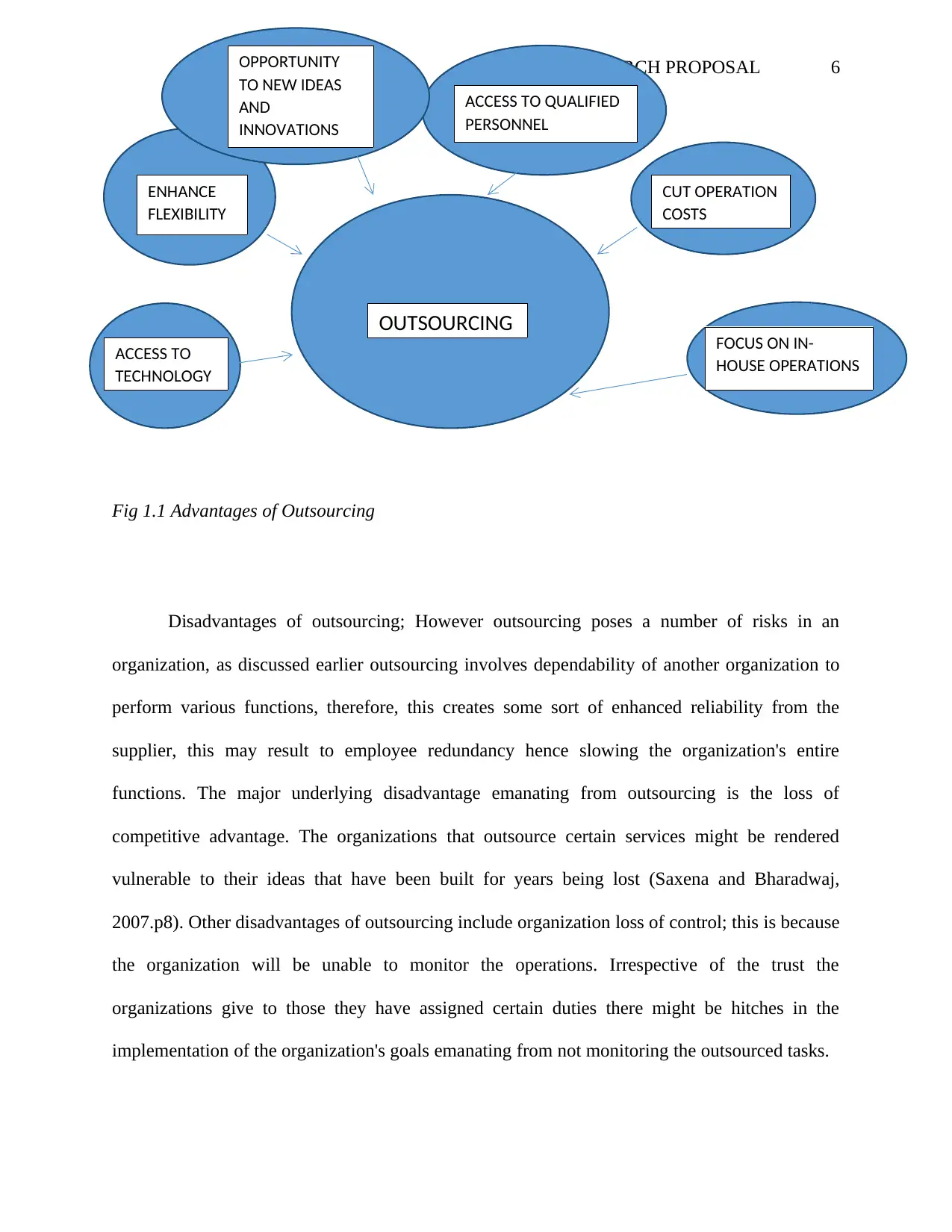
RESEARCH PROPOSAL 6
Fig 1.1 Advantages of Outsourcing
Disadvantages of outsourcing; However outsourcing poses a number of risks in an
organization, as discussed earlier outsourcing involves dependability of another organization to
perform various functions, therefore, this creates some sort of enhanced reliability from the
supplier, this may result to employee redundancy hence slowing the organization's entire
functions. The major underlying disadvantage emanating from outsourcing is the loss of
competitive advantage. The organizations that outsource certain services might be rendered
vulnerable to their ideas that have been built for years being lost (Saxena and Bharadwaj,
2007.p8). Other disadvantages of outsourcing include organization loss of control; this is because
the organization will be unable to monitor the operations. Irrespective of the trust the
organizations give to those they have assigned certain duties there might be hitches in the
implementation of the organization's goals emanating from not monitoring the outsourced tasks.
OUTSOURCING
ACCESS TO
TECHNOLOGY
ENHANCE
FLEXIBILITY
FOCUS ON IN-
HOUSE OPERATIONS
CUT OPERATION
COSTS
ACCESS TO QUALIFIED
PERSONNEL
OPPORTUNITY
TO NEW IDEAS
AND
INNOVATIONS
Fig 1.1 Advantages of Outsourcing
Disadvantages of outsourcing; However outsourcing poses a number of risks in an
organization, as discussed earlier outsourcing involves dependability of another organization to
perform various functions, therefore, this creates some sort of enhanced reliability from the
supplier, this may result to employee redundancy hence slowing the organization's entire
functions. The major underlying disadvantage emanating from outsourcing is the loss of
competitive advantage. The organizations that outsource certain services might be rendered
vulnerable to their ideas that have been built for years being lost (Saxena and Bharadwaj,
2007.p8). Other disadvantages of outsourcing include organization loss of control; this is because
the organization will be unable to monitor the operations. Irrespective of the trust the
organizations give to those they have assigned certain duties there might be hitches in the
implementation of the organization's goals emanating from not monitoring the outsourced tasks.
OUTSOURCING
ACCESS TO
TECHNOLOGY
ENHANCE
FLEXIBILITY
FOCUS ON IN-
HOUSE OPERATIONS
CUT OPERATION
COSTS
ACCESS TO QUALIFIED
PERSONNEL
OPPORTUNITY
TO NEW IDEAS
AND
INNOVATIONS
⊘ This is a preview!⊘
Do you want full access?
Subscribe today to unlock all pages.

Trusted by 1+ million students worldwide
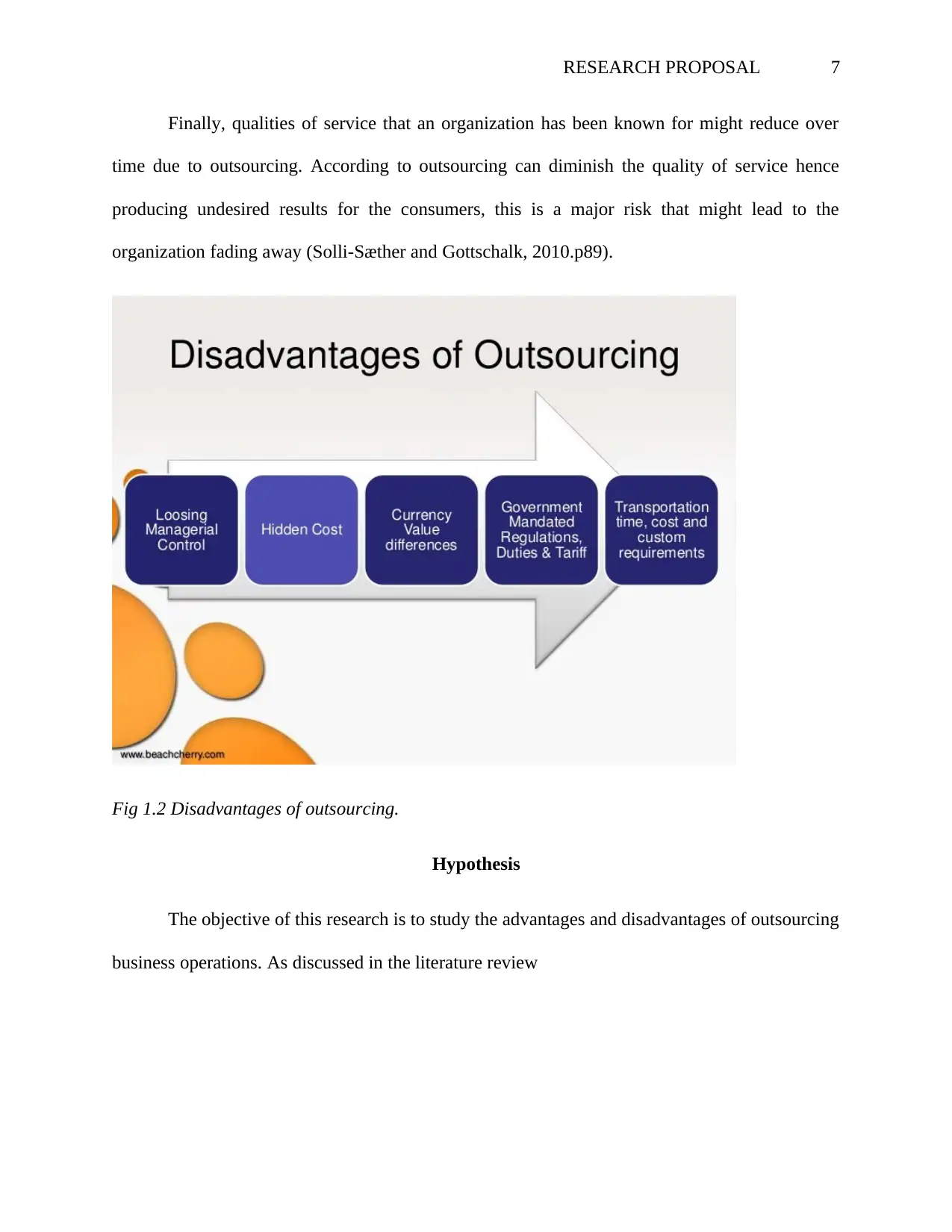
RESEARCH PROPOSAL 7
Finally, qualities of service that an organization has been known for might reduce over
time due to outsourcing. According to outsourcing can diminish the quality of service hence
producing undesired results for the consumers, this is a major risk that might lead to the
organization fading away (Solli-Sæther and Gottschalk, 2010.p89).
Fig 1.2 Disadvantages of outsourcing.
Hypothesis
The objective of this research is to study the advantages and disadvantages of outsourcing
business operations. As discussed in the literature review
Finally, qualities of service that an organization has been known for might reduce over
time due to outsourcing. According to outsourcing can diminish the quality of service hence
producing undesired results for the consumers, this is a major risk that might lead to the
organization fading away (Solli-Sæther and Gottschalk, 2010.p89).
Fig 1.2 Disadvantages of outsourcing.
Hypothesis
The objective of this research is to study the advantages and disadvantages of outsourcing
business operations. As discussed in the literature review
Paraphrase This Document
Need a fresh take? Get an instant paraphrase of this document with our AI Paraphraser
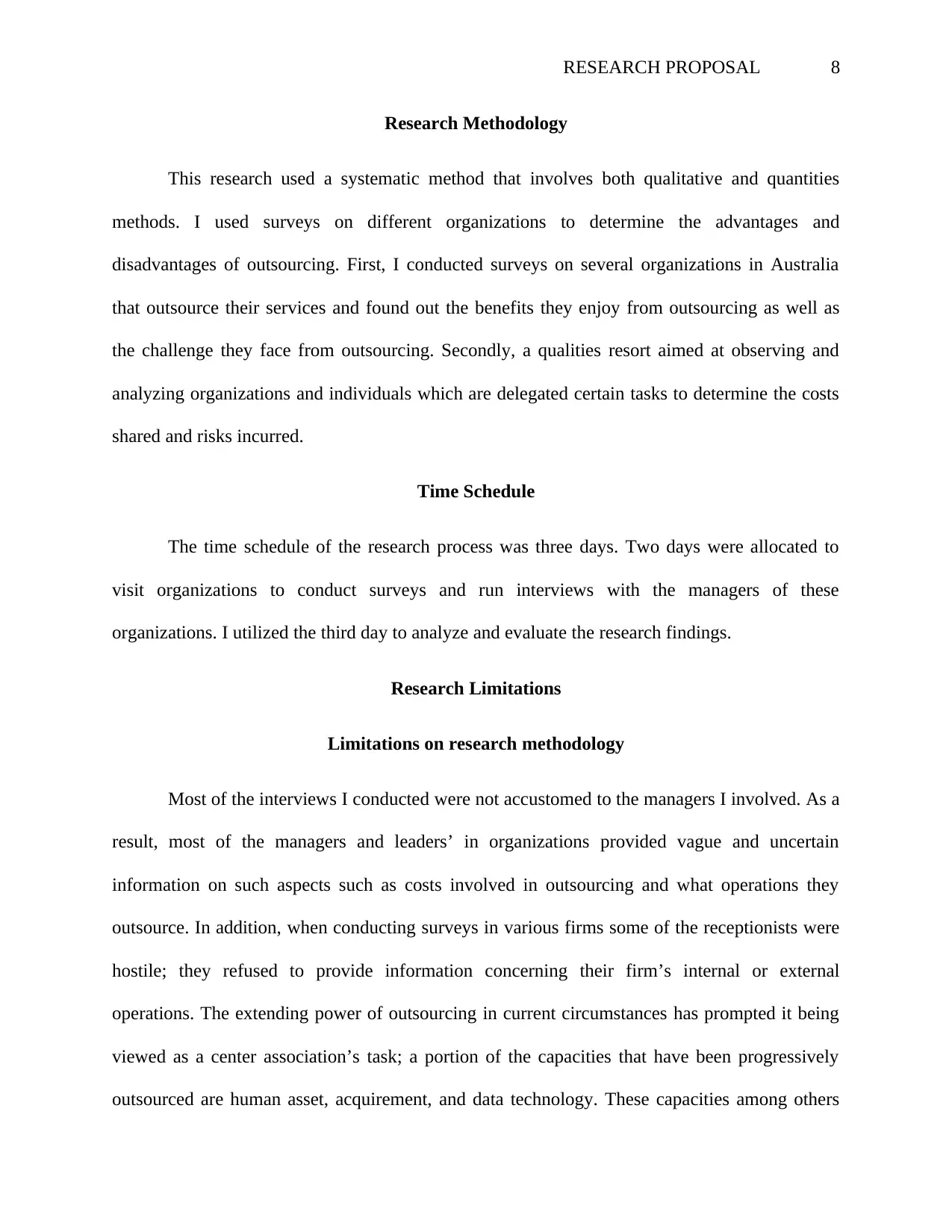
RESEARCH PROPOSAL 8
Research Methodology
This research used a systematic method that involves both qualitative and quantities
methods. I used surveys on different organizations to determine the advantages and
disadvantages of outsourcing. First, I conducted surveys on several organizations in Australia
that outsource their services and found out the benefits they enjoy from outsourcing as well as
the challenge they face from outsourcing. Secondly, a qualities resort aimed at observing and
analyzing organizations and individuals which are delegated certain tasks to determine the costs
shared and risks incurred.
Time Schedule
The time schedule of the research process was three days. Two days were allocated to
visit organizations to conduct surveys and run interviews with the managers of these
organizations. I utilized the third day to analyze and evaluate the research findings.
Research Limitations
Limitations on research methodology
Most of the interviews I conducted were not accustomed to the managers I involved. As a
result, most of the managers and leaders’ in organizations provided vague and uncertain
information on such aspects such as costs involved in outsourcing and what operations they
outsource. In addition, when conducting surveys in various firms some of the receptionists were
hostile; they refused to provide information concerning their firm’s internal or external
operations. The extending power of outsourcing in current circumstances has prompted it being
viewed as a center association’s task; a portion of the capacities that have been progressively
outsourced are human asset, acquirement, and data technology. These capacities among others
Research Methodology
This research used a systematic method that involves both qualitative and quantities
methods. I used surveys on different organizations to determine the advantages and
disadvantages of outsourcing. First, I conducted surveys on several organizations in Australia
that outsource their services and found out the benefits they enjoy from outsourcing as well as
the challenge they face from outsourcing. Secondly, a qualities resort aimed at observing and
analyzing organizations and individuals which are delegated certain tasks to determine the costs
shared and risks incurred.
Time Schedule
The time schedule of the research process was three days. Two days were allocated to
visit organizations to conduct surveys and run interviews with the managers of these
organizations. I utilized the third day to analyze and evaluate the research findings.
Research Limitations
Limitations on research methodology
Most of the interviews I conducted were not accustomed to the managers I involved. As a
result, most of the managers and leaders’ in organizations provided vague and uncertain
information on such aspects such as costs involved in outsourcing and what operations they
outsource. In addition, when conducting surveys in various firms some of the receptionists were
hostile; they refused to provide information concerning their firm’s internal or external
operations. The extending power of outsourcing in current circumstances has prompted it being
viewed as a center association’s task; a portion of the capacities that have been progressively
outsourced are human asset, acquirement, and data technology. These capacities among others
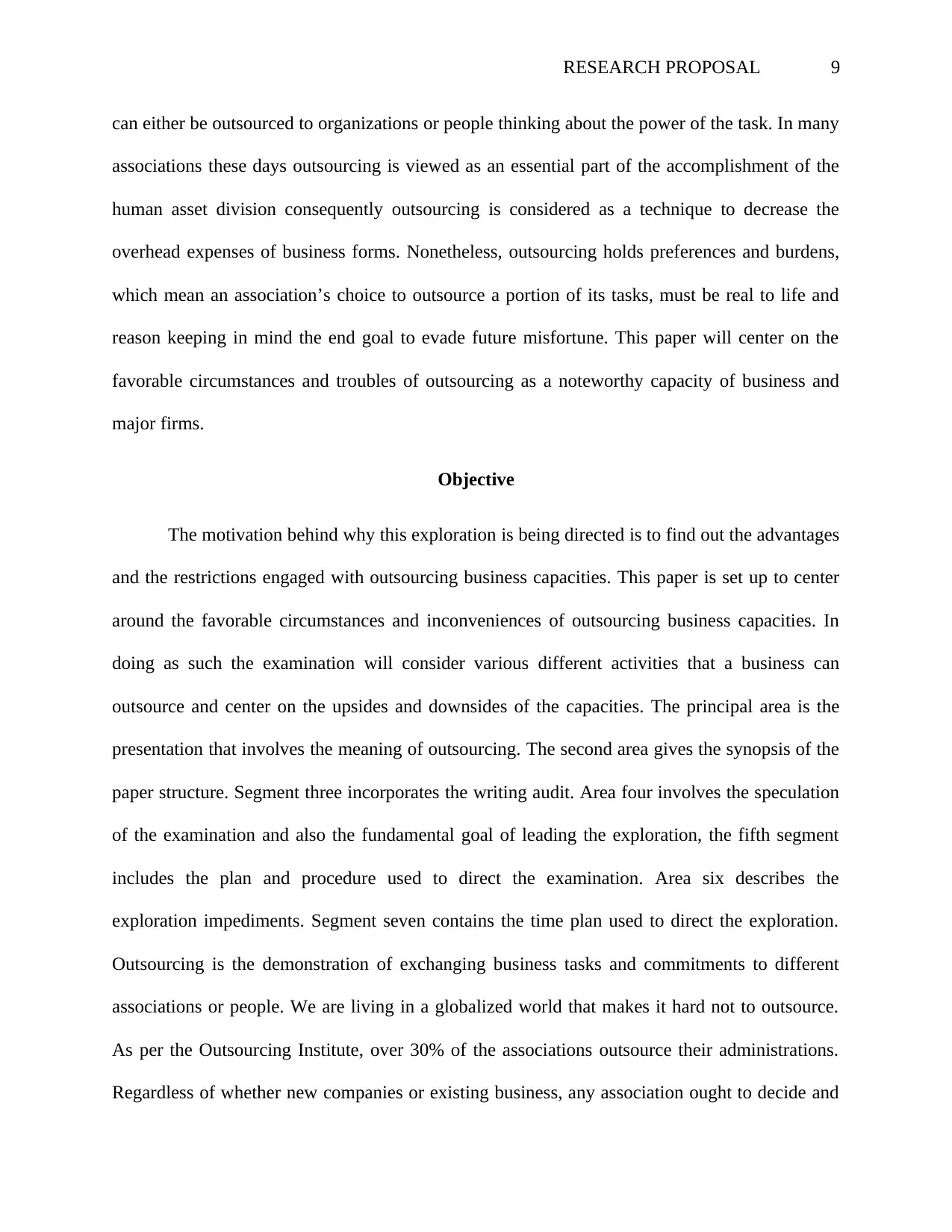
RESEARCH PROPOSAL 9
can either be outsourced to organizations or people thinking about the power of the task. In many
associations these days outsourcing is viewed as an essential part of the accomplishment of the
human asset division consequently outsourcing is considered as a technique to decrease the
overhead expenses of business forms. Nonetheless, outsourcing holds preferences and burdens,
which mean an association’s choice to outsource a portion of its tasks, must be real to life and
reason keeping in mind the end goal to evade future misfortune. This paper will center on the
favorable circumstances and troubles of outsourcing as a noteworthy capacity of business and
major firms.
Objective
The motivation behind why this exploration is being directed is to find out the advantages
and the restrictions engaged with outsourcing business capacities. This paper is set up to center
around the favorable circumstances and inconveniences of outsourcing business capacities. In
doing as such the examination will consider various different activities that a business can
outsource and center on the upsides and downsides of the capacities. The principal area is the
presentation that involves the meaning of outsourcing. The second area gives the synopsis of the
paper structure. Segment three incorporates the writing audit. Area four involves the speculation
of the examination and also the fundamental goal of leading the exploration, the fifth segment
includes the plan and procedure used to direct the examination. Area six describes the
exploration impediments. Segment seven contains the time plan used to direct the exploration.
Outsourcing is the demonstration of exchanging business tasks and commitments to different
associations or people. We are living in a globalized world that makes it hard not to outsource.
As per the Outsourcing Institute, over 30% of the associations outsource their administrations.
Regardless of whether new companies or existing business, any association ought to decide and
can either be outsourced to organizations or people thinking about the power of the task. In many
associations these days outsourcing is viewed as an essential part of the accomplishment of the
human asset division consequently outsourcing is considered as a technique to decrease the
overhead expenses of business forms. Nonetheless, outsourcing holds preferences and burdens,
which mean an association’s choice to outsource a portion of its tasks, must be real to life and
reason keeping in mind the end goal to evade future misfortune. This paper will center on the
favorable circumstances and troubles of outsourcing as a noteworthy capacity of business and
major firms.
Objective
The motivation behind why this exploration is being directed is to find out the advantages
and the restrictions engaged with outsourcing business capacities. This paper is set up to center
around the favorable circumstances and inconveniences of outsourcing business capacities. In
doing as such the examination will consider various different activities that a business can
outsource and center on the upsides and downsides of the capacities. The principal area is the
presentation that involves the meaning of outsourcing. The second area gives the synopsis of the
paper structure. Segment three incorporates the writing audit. Area four involves the speculation
of the examination and also the fundamental goal of leading the exploration, the fifth segment
includes the plan and procedure used to direct the examination. Area six describes the
exploration impediments. Segment seven contains the time plan used to direct the exploration.
Outsourcing is the demonstration of exchanging business tasks and commitments to different
associations or people. We are living in a globalized world that makes it hard not to outsource.
As per the Outsourcing Institute, over 30% of the associations outsource their administrations.
Regardless of whether new companies or existing business, any association ought to decide and
⊘ This is a preview!⊘
Do you want full access?
Subscribe today to unlock all pages.

Trusted by 1+ million students worldwide
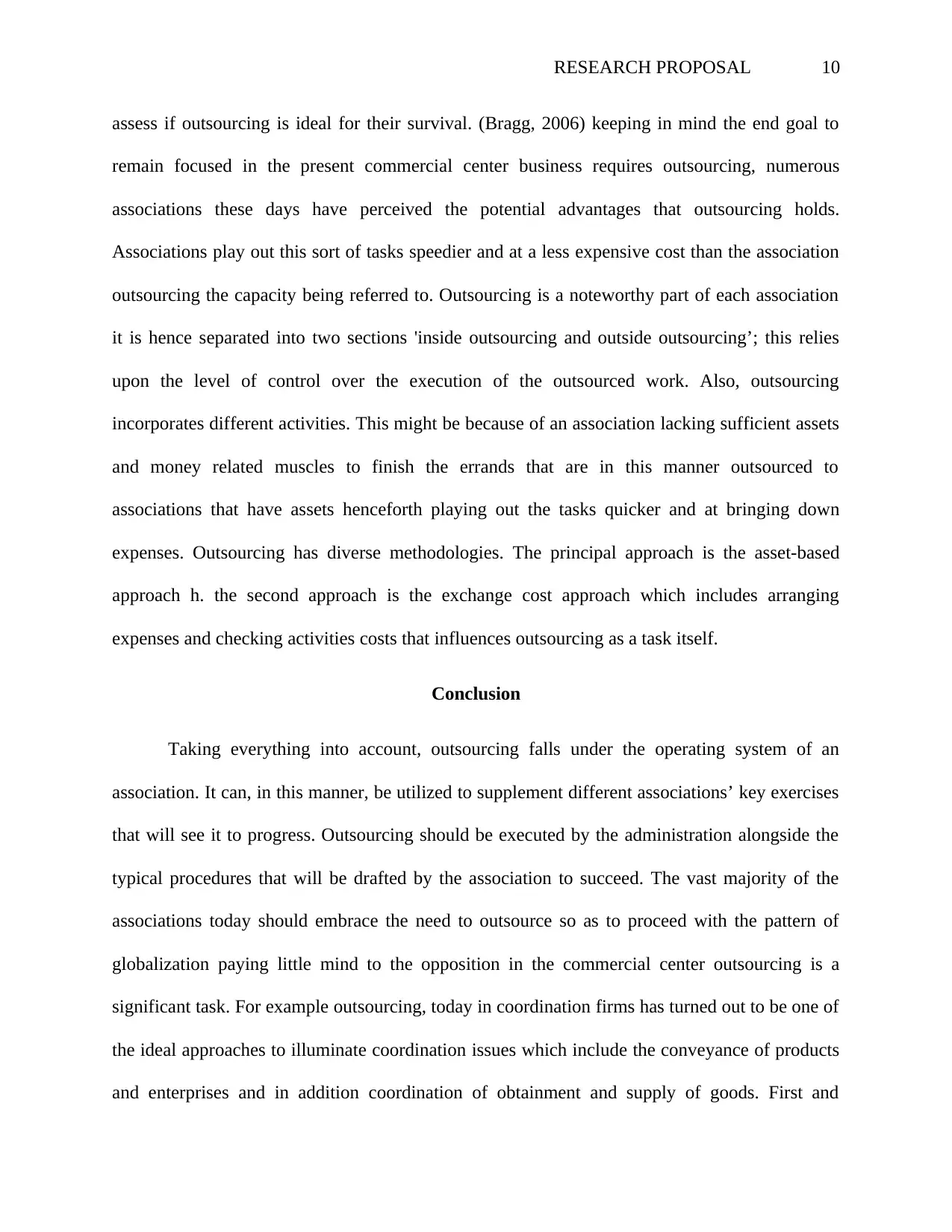
RESEARCH PROPOSAL 10
assess if outsourcing is ideal for their survival. (Bragg, 2006) keeping in mind the end goal to
remain focused in the present commercial center business requires outsourcing, numerous
associations these days have perceived the potential advantages that outsourcing holds.
Associations play out this sort of tasks speedier and at a less expensive cost than the association
outsourcing the capacity being referred to. Outsourcing is a noteworthy part of each association
it is hence separated into two sections 'inside outsourcing and outside outsourcing’; this relies
upon the level of control over the execution of the outsourced work. Also, outsourcing
incorporates different activities. This might be because of an association lacking sufficient assets
and money related muscles to finish the errands that are in this manner outsourced to
associations that have assets henceforth playing out the tasks quicker and at bringing down
expenses. Outsourcing has diverse methodologies. The principal approach is the asset-based
approach h. the second approach is the exchange cost approach which includes arranging
expenses and checking activities costs that influences outsourcing as a task itself.
Conclusion
Taking everything into account, outsourcing falls under the operating system of an
association. It can, in this manner, be utilized to supplement different associations’ key exercises
that will see it to progress. Outsourcing should be executed by the administration alongside the
typical procedures that will be drafted by the association to succeed. The vast majority of the
associations today should embrace the need to outsource so as to proceed with the pattern of
globalization paying little mind to the opposition in the commercial center outsourcing is a
significant task. For example outsourcing, today in coordination firms has turned out to be one of
the ideal approaches to illuminate coordination issues which include the conveyance of products
and enterprises and in addition coordination of obtainment and supply of goods. First and
assess if outsourcing is ideal for their survival. (Bragg, 2006) keeping in mind the end goal to
remain focused in the present commercial center business requires outsourcing, numerous
associations these days have perceived the potential advantages that outsourcing holds.
Associations play out this sort of tasks speedier and at a less expensive cost than the association
outsourcing the capacity being referred to. Outsourcing is a noteworthy part of each association
it is hence separated into two sections 'inside outsourcing and outside outsourcing’; this relies
upon the level of control over the execution of the outsourced work. Also, outsourcing
incorporates different activities. This might be because of an association lacking sufficient assets
and money related muscles to finish the errands that are in this manner outsourced to
associations that have assets henceforth playing out the tasks quicker and at bringing down
expenses. Outsourcing has diverse methodologies. The principal approach is the asset-based
approach h. the second approach is the exchange cost approach which includes arranging
expenses and checking activities costs that influences outsourcing as a task itself.
Conclusion
Taking everything into account, outsourcing falls under the operating system of an
association. It can, in this manner, be utilized to supplement different associations’ key exercises
that will see it to progress. Outsourcing should be executed by the administration alongside the
typical procedures that will be drafted by the association to succeed. The vast majority of the
associations today should embrace the need to outsource so as to proceed with the pattern of
globalization paying little mind to the opposition in the commercial center outsourcing is a
significant task. For example outsourcing, today in coordination firms has turned out to be one of
the ideal approaches to illuminate coordination issues which include the conveyance of products
and enterprises and in addition coordination of obtainment and supply of goods. First and
Paraphrase This Document
Need a fresh take? Get an instant paraphrase of this document with our AI Paraphraser
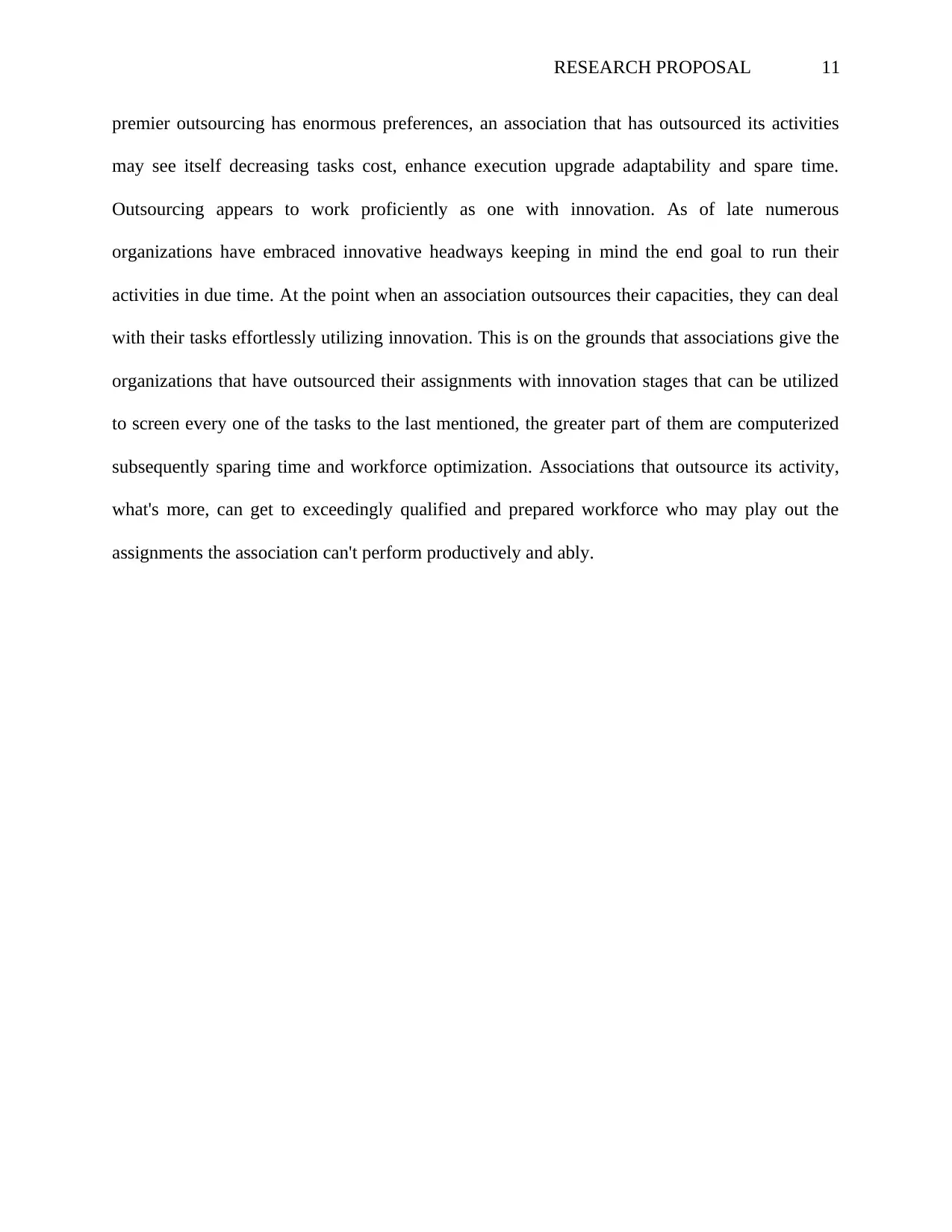
RESEARCH PROPOSAL 11
premier outsourcing has enormous preferences, an association that has outsourced its activities
may see itself decreasing tasks cost, enhance execution upgrade adaptability and spare time.
Outsourcing appears to work proficiently as one with innovation. As of late numerous
organizations have embraced innovative headways keeping in mind the end goal to run their
activities in due time. At the point when an association outsources their capacities, they can deal
with their tasks effortlessly utilizing innovation. This is on the grounds that associations give the
organizations that have outsourced their assignments with innovation stages that can be utilized
to screen every one of the tasks to the last mentioned, the greater part of them are computerized
subsequently sparing time and workforce optimization. Associations that outsource its activity,
what's more, can get to exceedingly qualified and prepared workforce who may play out the
assignments the association can't perform productively and ably.
premier outsourcing has enormous preferences, an association that has outsourced its activities
may see itself decreasing tasks cost, enhance execution upgrade adaptability and spare time.
Outsourcing appears to work proficiently as one with innovation. As of late numerous
organizations have embraced innovative headways keeping in mind the end goal to run their
activities in due time. At the point when an association outsources their capacities, they can deal
with their tasks effortlessly utilizing innovation. This is on the grounds that associations give the
organizations that have outsourced their assignments with innovation stages that can be utilized
to screen every one of the tasks to the last mentioned, the greater part of them are computerized
subsequently sparing time and workforce optimization. Associations that outsource its activity,
what's more, can get to exceedingly qualified and prepared workforce who may play out the
assignments the association can't perform productively and ably.
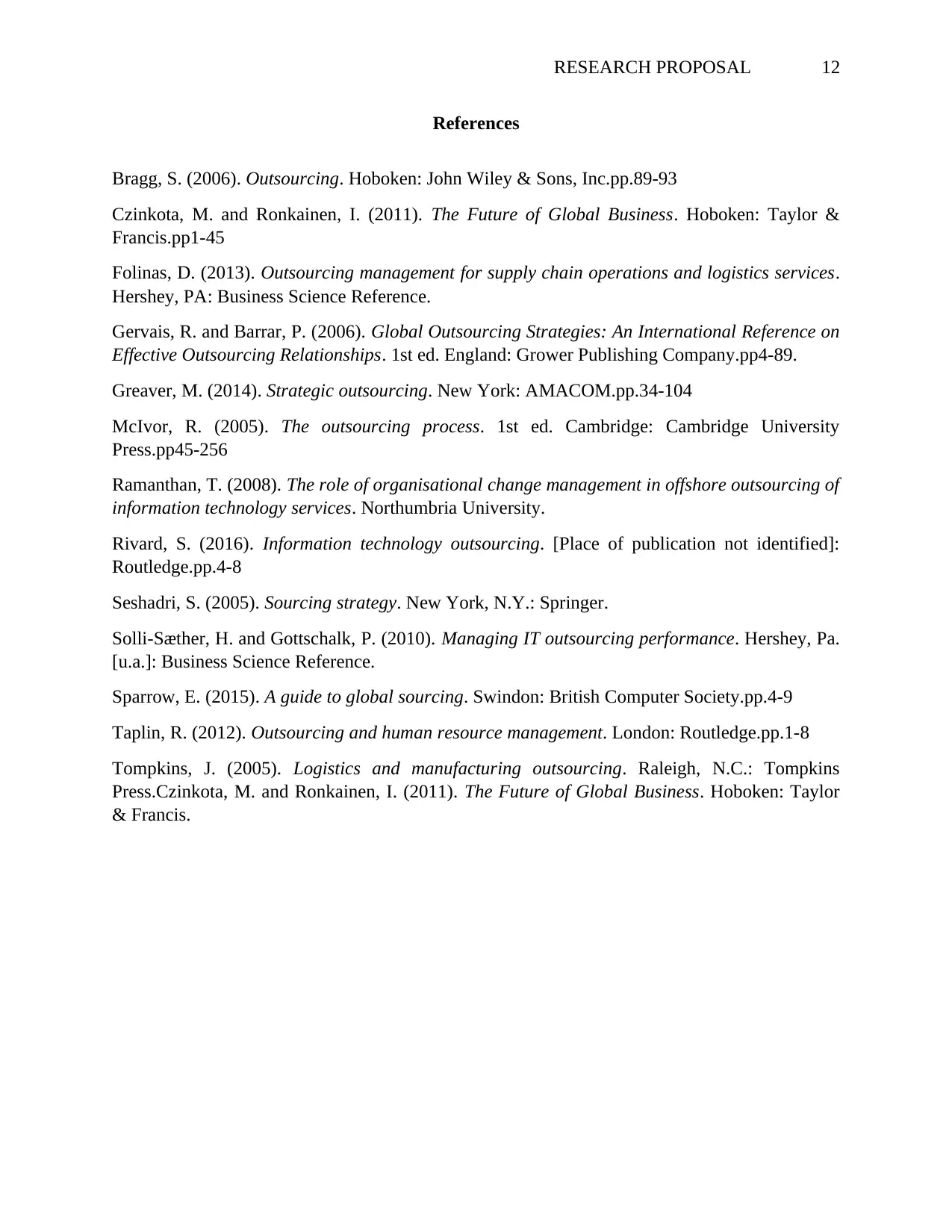
RESEARCH PROPOSAL 12
References
Bragg, S. (2006). Outsourcing. Hoboken: John Wiley & Sons, Inc.pp.89-93
Czinkota, M. and Ronkainen, I. (2011). The Future of Global Business. Hoboken: Taylor &
Francis.pp1-45
Folinas, D. (2013). Outsourcing management for supply chain operations and logistics services.
Hershey, PA: Business Science Reference.
Gervais, R. and Barrar, P. (2006). Global Outsourcing Strategies: An International Reference on
Effective Outsourcing Relationships. 1st ed. England: Grower Publishing Company.pp4-89.
Greaver, M. (2014). Strategic outsourcing. New York: AMACOM.pp.34-104
McIvor, R. (2005). The outsourcing process. 1st ed. Cambridge: Cambridge University
Press.pp45-256
Ramanthan, T. (2008). The role of organisational change management in offshore outsourcing of
information technology services. Northumbria University.
Rivard, S. (2016). Information technology outsourcing. [Place of publication not identified]:
Routledge.pp.4-8
Seshadri, S. (2005). Sourcing strategy. New York, N.Y.: Springer.
Solli-Sæther, H. and Gottschalk, P. (2010). Managing IT outsourcing performance. Hershey, Pa.
[u.a.]: Business Science Reference.
Sparrow, E. (2015). A guide to global sourcing. Swindon: British Computer Society.pp.4-9
Taplin, R. (2012). Outsourcing and human resource management. London: Routledge.pp.1-8
Tompkins, J. (2005). Logistics and manufacturing outsourcing. Raleigh, N.C.: Tompkins
Press.Czinkota, M. and Ronkainen, I. (2011). The Future of Global Business. Hoboken: Taylor
& Francis.
References
Bragg, S. (2006). Outsourcing. Hoboken: John Wiley & Sons, Inc.pp.89-93
Czinkota, M. and Ronkainen, I. (2011). The Future of Global Business. Hoboken: Taylor &
Francis.pp1-45
Folinas, D. (2013). Outsourcing management for supply chain operations and logistics services.
Hershey, PA: Business Science Reference.
Gervais, R. and Barrar, P. (2006). Global Outsourcing Strategies: An International Reference on
Effective Outsourcing Relationships. 1st ed. England: Grower Publishing Company.pp4-89.
Greaver, M. (2014). Strategic outsourcing. New York: AMACOM.pp.34-104
McIvor, R. (2005). The outsourcing process. 1st ed. Cambridge: Cambridge University
Press.pp45-256
Ramanthan, T. (2008). The role of organisational change management in offshore outsourcing of
information technology services. Northumbria University.
Rivard, S. (2016). Information technology outsourcing. [Place of publication not identified]:
Routledge.pp.4-8
Seshadri, S. (2005). Sourcing strategy. New York, N.Y.: Springer.
Solli-Sæther, H. and Gottschalk, P. (2010). Managing IT outsourcing performance. Hershey, Pa.
[u.a.]: Business Science Reference.
Sparrow, E. (2015). A guide to global sourcing. Swindon: British Computer Society.pp.4-9
Taplin, R. (2012). Outsourcing and human resource management. London: Routledge.pp.1-8
Tompkins, J. (2005). Logistics and manufacturing outsourcing. Raleigh, N.C.: Tompkins
Press.Czinkota, M. and Ronkainen, I. (2011). The Future of Global Business. Hoboken: Taylor
& Francis.
⊘ This is a preview!⊘
Do you want full access?
Subscribe today to unlock all pages.

Trusted by 1+ million students worldwide
1 out of 13
Related Documents
Your All-in-One AI-Powered Toolkit for Academic Success.
+13062052269
info@desklib.com
Available 24*7 on WhatsApp / Email
![[object Object]](/_next/static/media/star-bottom.7253800d.svg)
Unlock your academic potential
Copyright © 2020–2025 A2Z Services. All Rights Reserved. Developed and managed by ZUCOL.



